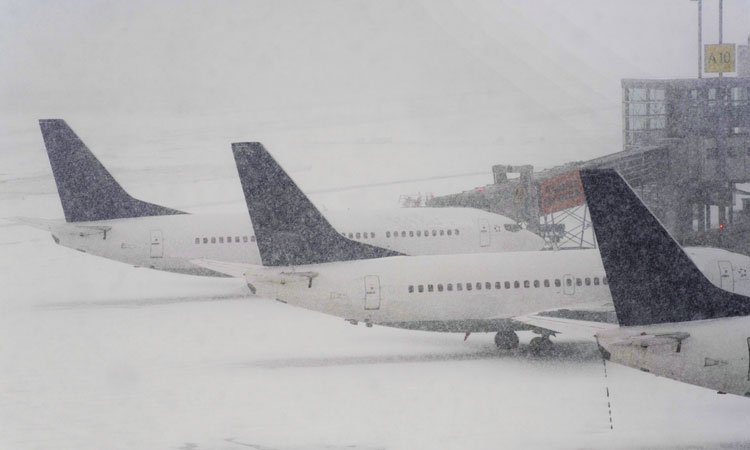Snow, but not snowed under – coping with the weather
Posted: 13 August 2014 | Joe Sultana | No comments yet
Information sharing is vital during bad winter weather and the more timely information the Network Manager has, the better service it can provide, says Joe Sultana, Director of the Network Manger Directorate at EUROCONTROL


Severe weather hampers airlines and airports. It affects flight punctuality; makes for problems with the rotation of aircraft when flights are diverted; obstructs flight efficiency and – not least of all – jeopardises the achievement of flight efficiency targets, both locally and for Europe’s entire air traffic management (ATM) network.
However, weather-related delays can be reduced if these three criteria are in place:
- A robust, accurate weather forecast
- A proper assessment of weather-related risks
- Well-timed, collaborative decision-making processes based on precise, shared information and delay impact assessment simulations made by the Network Manager Operations Centre, NMOC.
Timing is crucial. Regulations that are applied too late will affect workload and efficiency, while late regulations generate extra disruption if aircraft have to hold or be diverted. A great deal of disruption can be avoided if decisions are taken two to three hours ahead of the expected weather issue.
The Network Manager, in close collaboration with all its partners, has a range of tools, processes and procedures to facilitate decision-making processes, enhance situational awareness and improve predictability.
A smooth running network
When bad weather incapacitates airports, the NMOC immediately analyses and assesses the situation. It then contacts the aircraft operators, FMPs (Flow Management Positions) and the affected airports. Consultation, coordination and collaboration are the key to a smooth running network.
The Aircraft Operators Liaison Officers, working in the NMOC, review and update measures as the weather evolves. They also stay in constant contact with those airports that affect the network, sharing detailed information on the local situation and the level of preparation required.
Plenty of teleconferences are held and we speak directly with airports, airlines, air navigation service providers (ANSPs), weather experts, airline associations (such as IATA, ERA and IACA) about how the situation is evolving. Everyone is given a transparent and up-to-the-minute picture of the situation, including capacity levels and diversion capabilities; allowing all parties to manage their operational decisions, such as flight cancellations and re-routings.
We constantly monitor the forecast and current weather situation and keep the FMPs informed. This information is then published on the Network Operations Portal (NOP) for the mutual benefit of all. It is updated constantly, giving details of the depth of snow, diversions, delays and arrival capacities.
NOTAMs (Notices to Airmen) are published as requested by the relevant authorities and the information is posted on the NOP. The Network Manager works hard to improve overall predictability, implement mitigation measures (for example planning diversions to unaffected airports; preventing flights from going to affected airports; avoiding airspace congestion) and expedite the post-event recovery process.
Air traffic flow and capacity management measures, such as city-pair flight level capping and specific Route Availability Document measures are examined and the best one chosen so as to offer airspace users a range of options that best meet their needs.
The Network Manager reviews and updates the measures as the weather evolves, staying in constant contact with all stakeholders, sharing detailed information with them so that they can plan accordingly.
EUROCONTROL has a number of tools and programmes (detailed below) which help with capacity issues and are particularly useful during the winter season when snow and ice disrupt airport operations.
A-CDM
Airport Collaborative Decision Making (A-CDM) is a powerful enabler for reducing airport and en route delays in Europe as it integrates airports into the ATM network. Flight punctuality and overall network efficiency improve as airport partners work together to optimise aircraft turnaround, reduce taxi times and make the most of existing airport capacity.
One feature that brings a quantifiable benefit is the Target Off-Block Time (TOBT), which gives an accurate estimation of the time when the aircraft is ready to move, doors closed. The handling agent provides the TOBT.
Another feature that helps move the aircraft from the apron to the runway, in the right order for departure, is the Target Start-up Approval Time (TSAT), which allows air traffic controllers to optimise the order in which aircraft arrive at the runway. The pilot gives ATC the TSAT, which takes the TOBT and traffic situation into account.
TSATs reduce queuing time at the runway and make for good runway utilisation. The airport operator uses the TSAT to know when the flight will be ready to leave the stand; the ground handling services use it to be able to pinpoint the moment when they can carry out the final actions in readying a flight for departure.
Naturally, in winter, A-CDM comes into its own for de-icing procedures – and TSATs help ensure that there is not too long a gap between de-icing and take-off. Having the ground resources available at the right place at the right time is a necessity at all airports, but at large airports, there is added complexity. The intricate layout of the runways and taxiways increases the amount of time aircraft need to reach their runway. So, another A-CDM feature is brought into play.
Variable Taxi Time is a set of parameters that allow ground resources to be used more effectively. Inbound taxi time (EXIT) includes runway occupancy and ground movement time, whereas outbound taxi time (EXOT) includes push-back and start-up time, ground movement, remote or apron de-icing, and runway holding times. Variable Taxi Time is used to calculate the most accurate TSAT.
Take-Off Time is included in the Departure Planning Information messages sent by CDM Airports to the NMOC. Having this accurate flight-by-flight information from airports allows the Network Manager to organise traffic flows more efficiently.
Over 30 airports in Europe are at various stages of implementing A-CDM and they are reporting both significant gains in capacity and environmental benefits as fuel burn and emissions are reduced.
Natural hazards and weather resilience tool
The Network Manager has developed a natural hazards and weather resilience tool to analyse the impact of weather on the ATM network. The tool has a map displaying all en route sectors and airports which might have their capacity reduced because of severe weather or other natural hazards.
A risk score is calculated for each airport or sector, based on the hazard probability (x per cent of probability of the specific event) and the impact severity (potential reduction of capacity because of the event, combined with its potential impact on the network overall).
This tool gives the Network Manager a global view of how the weather event will affect network operations. A sophisticated Risk Assessment Model is used to make the calculations; results are distributed via a web-based graphical user interface. This pre-tactical tool helps us with crisis management as well as in our performance planning and monitoring: we can calibrate historical daily delays with the actual impact risk.
In the future, the model’s outputs will be integrated into the NOP and used to develop informed mitigation strategies for identified risks and so help enrich the entire network’s collaborative decision-making capabilities.
Waking up
With major airports battling with over-demand at peak traffic times, runways are heavily constrained. So, increased runway throughput and resilience are needed now more than ever. Applying adapted wake vortex separation minima can help increase runway capacity by as much as five per cent during peak times.
EUROCONTROL has been involved in wake vortex studies since 2002 and has amassed the word’s largest wake vortex database. Based on this knowledge, we have been able to develop a number of improvement projects, supported by a recategorisation of wake separations.
The traditional ICAO recommendations for wake vortex separation are based on just three categories – light, medium and heavy. But with better knowledge of wake behaviour based on a wealth of wake data, new metrics have been developed, taking real wake strength and airframes’ ability to resist it into account.
This wake vortex re-categorisation exercise (RECAT) is about to enter its third phase. The first phase saw the definition of six categories, formed by splitting the ICAO Medium and Heavy categories into two and adding a new super category for the Airbus A380. RECAT 2 defines separations for each pair of aircraft from a matrix of 115 by 115, covering more than 95 per cent of common aircraft in global use.
The next step, RECAT 3, will give an extra level of flexibility in applying separations, using meteorological data from ground and air systems to mitigate wake.
Allied to RECAT, the wake knowledge that has been developed is being used in projects such as Time-Based Separation (planned for deployment at Heathrow next year), crosswind-based separation reductions, multiple or adaptive landing thresholds and adaptive glide slopes.
All about planning
The network runs smoothly when there is proper planning and a consolidated overview of problems and issues so that corrective action can be taken quickly and fairly, for the benefit of all players. The Network Manager is in a position to do this but it naturally relies on the input of all its partners: airports, airspace users, ANSPs.
By working together, we can make a sizeable difference to the efficiency and throughput of our ATM system.
We were fortunate that the winter of 2013-2014 was not as severe as preceding ones, but our objective is still the same: to capture best practices, improve collaboration and exchange more information. Our particular concern for winter 2014-2015 is to fine-tune the timing of implementing regulations. We rely on our partners to help us perfect this.
How can airports help when the weather is bad?
It helps enormously if airports can share their intentions with the Network Manager when bad weather has been forecast for them. In order to operate the network efficiently, as much information as possible is needed from all parties so that the best decisions can be taken.
A good way for airports to find out what is likely to happen in winter weather is to consult the Digital SNOWTAM (www.eurocontrol.int/services/digital-snowtam), which gives clear, accurate and easy-to-understand information about runway contamination with snow and ice, using a graphical display in the form of an overview map.
It would be helpful if airports could be proactive and apply regulations in good time, that is, two to three hours in advance: last-minute regulations lead to more holding and extra delay.
Does the Network Manager have the latest contact lists of your staff? It helps considerably if the Network Manager can interact frequently with airport staff and authorities when winter weather strikes, but up-to-date contact details are needed to do this!
Information sharing is vital in times of bad weather: the more precise, timely information the Network Manager has from airports, the better the service it can provide.
Biography
Joe Sultana has been the Director of the Network Manager Directorate since 1 July 2013. He graduated from the University of Malta with an Engineering Degree in 1975 before joining the Air Traffic Services Unit in Malta. He holds ATCO licences in aerodrome, radar and area control and was a Watch Supervisor for four years. In 1982, Joe was appointed Head of Air Traffic Services in the Maltese Department of Civil Aviation, becoming Deputy Director two years later. He joined EUROCONTROL in 1991 as an Airspace Management Expert and was in charge of the Agency’s RVSM programme from 1998 to 2002 which the programme was successfully implemented in 41 states. Joe went on to hold several senior management positions within EUROCONTROL, becoming its Chief Operating Officer in 2011. He is now responsible for all the Network Manager’s functions.
Stay Connected with International Airport Review — Subscribe for Free!
Get exclusive access to the latest airport and aviation industry insights from International Airport Review — tailored to your interests.
✅ Expert-Led Webinars – Gain insights from global aviation leaders
✅ Weekly News & Reports – Airport innovation, thought leadership, and industry trends
✅ Exclusive Industry Insights – Discover cutting-edge technologies shaping the future of air travel
✅ International Airport Summit – Join our flagship event to network with industry leaders and explore the latest advancements
Choose the updates that matter most to you.
Sign up now to stay informed, inspired, and connected — all for free!
Thank you for being part of our aviation community. Let’s keep shaping the future of airports together!
Issue
Related topics
Air traffic control/management (ATC/ATM), Airport Collaborative Decision Making (A-CDM), Airport development, Airside operations, New technologies, Passenger experience and seamless travel, Regulation and Legislation, Winter operations


















